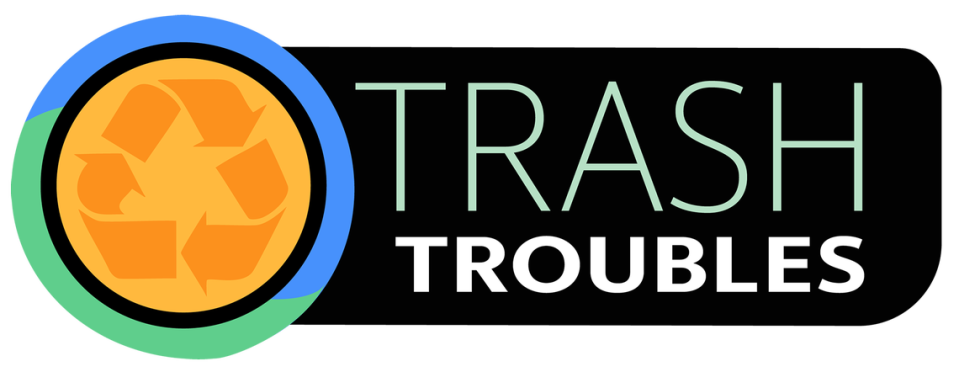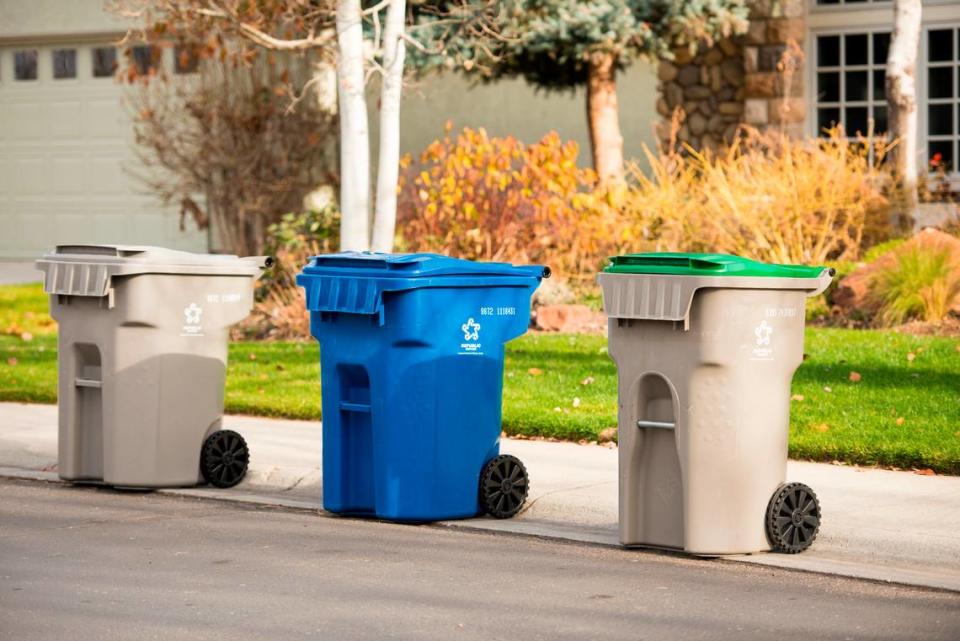Confused about Boise recycling? You’re not alone. Here are some tips for what goes where
In Caren Sage’s Boise home, plastic is a hot topic.
Her family participates in the Hefty ReNew recycling program, which Boise implemented in 2018. Residents can use the orange bags for plastics Nos. 4-7 that are deemed “unrecyclable” or hard to recycle, and Nos. 1 and 2 plastics can go in regular recycling.
But working out which plastics go where isn’t always easy, and at Sage’s house, it’s even a source of tension.

“If there’s one thing that causes arguments in my house, it’s where to put things (for recycling),” Sage told the Idaho Statesman during a recycling event at the Boise Farmers Market in July.
Something as simple as breakfast can turn into a head-scratching flowchart of waste analysis. Used coffee grounds and eggshells go into compost. Bacon grease goes in the trash. An empty plastic orange-juice bottle goes into recycling, so long as it’s a No. 1 or 2 plastic. But where does that bottle’s lid belong?
A cardboard cereal box goes into recycling, but the flimsy plastic bag inside it must go elsewhere. In Sage’s house, that bag will join a No. 5 plastic yogurt container in the Hefty ReNew orange bag, a separate container for plastics that are hard to recycle.
Deciphering the various types of waste is confusing, and city waste experts said it’s the top complaint they hear about Boise’s recycling program.
“People get frustrated with the complexity of what goes where,” said Peter McCullough, materials management program manager for Boise.

What goes where in Boise recycling
Confusion has been a constant since the first recycling center opened in Boise in late 1970. Letters to the editor in the Idaho Statesman questioned whether tin cans could be recycled (not at the time), if labels needed to be taken off glass bottles (yes), and whether the Statesman itself could be recycled (yes).
The small center, which was run by a Boise High School student, gave way to multiple private recycling centers before city and county residential recycling programs began in the 1990s. By 2009, Boise gave up small bins with separated materials in favor of today’s big blue carts where plastic, paper, aluminum and cardboard can commingle.
Compost added another waste destination in 2017: green carts. Orange bags debuted in Boise the following year.
Here are some rules of thumb for today’s recycling program:
Paper, cardboard and metal items like soda cans and canned food tins go in regular recycling. That’s the blue bin residents get through Republic Services. Those items don’t need to be separated from one another or bagged in any way.

Don’t put glass in the blue bin. Boise residents can sign up for a dedicated glass recycling cart that is collected once a month. It costs $7. Glass can also be taken to drop-off locations around the city. A map of those locations is available on the city website.
Plastics are trickier. A lot trickier.
Plastics are perplexing
Start by looking closely at the number displayed on many plastic items inside the triangular chasing-arrows symbol.
(That symbol, sans the number inside, has been the universal symbol for recycling since its creation in the 1970s. But the plastics industry says the symbol with the number inside does not mean the plastic is actually recyclable. The U.S. Environmental Protection Agency calls combining the two “deceptive,” and the Plastics Industry Association calls it “inappropriate.” The chasing arrows may eventually be replaced by a plain triangle.)
Remember, only Nos. 1 and 2 plastics can go into your blue bin. Nos. 4, 5, 6 and 7 go in orange bags.
No. 3 plastic is polyvinyl chloride, or PVC — commonly used in plumbing and other construction applications. Boise residents should put PVC in the trash. While the material is technically recyclable, there is no local infrastructure for it. Recycling PVC can be especially challenging because the plastic releases corrosive, harmful gases when exposed to extreme heat.
You can use the structure and texture of an object to help determine where it belongs. Styrofoams, like traditional packing peanuts, and filmy plastics like bread bags and plastic shopping bags typically go in orange bags.
There’s an alternative to orange bags for filmy plastics: You can bring them to local grocery chains that have plastic-bag recycling bins near their entrances. Albertsons, Fred Meyer, Walmart and WinCo have them.
Do plastic bags shoppers return to Boise-area stores actually get recycled? What we learned
If Nos. 1 and 2 bottles have a lid, leave it attached to the bottle and recycle it in the blue bin, even if the lid is a different color. If the lid detached from a plastic ring, recycle the ring too.
Loose plastic caps go in orange bags or in the trash.
McCullough, the city’s materials program manager, said it’s always helpful when residents break their items down into any component parts — for example, removing the plastic film window from junk mail or pasta boxes so the paper and cardboard can go in the blue bin, and the filmy plastic can go in the orange bag. But it’s not required.
Residents can remove filmy labels wrapped around some plastic beverage containers, put the label in the orange bag and the plastic wherever its number indicates it belongs. Doing so makes for higher-quality materials when the plastics are processed. But if you don’t remove the label, the bottles can still be put in your blue bin.

Don’t recycle crinkly bottles, clamshells
Still reading? Good. Because there are exceptions to the above rules that recyclers need to know.
There are two types of plastic items that should always go into the trash: crinkly No. 1 water bottles — the kind that can be crushed flat easily — and clamshells, like the kinds salad greens or strawberries are frequently sold in, whatever their plastic number. City officials said that’s because those plastics are soft and lightweight enough to be incorrectly sorted at recycling centers, potentially contaminating other items or gumming up machinery.
Sage said her family acquires a lot of those clamshells with spinach and other greens, and the containers were a major point of confusion. Cathy Chertudi, a former city environmental programs manager who now works with Hefty on the ReNew program, looked through one of Sage’s family’s orange bags at the Farmers Market and told Sage to be sure to place those items in the trash.
In doubt? Throw it out.
Chertudi said any item that raises questions is better off in the trash than potentially contaminating recycling.
Sage said she’s familiar with that approach. “My battle cry is, ‘When in doubt, throw it out,’ ” she said.
Chertudi and city public works spokesperson Melissa Stoner said the idea of throwing certain items in the trash can be a tough pill for some people to swallow. They said some residents put nonrecyclable items — like the plastic clamshells, or wax-coated cardboard milk cartons — in their blue bins or orange bags because they’re unsure where the item belongs and hope that it may be recyclable.
The recycling industry calls this aspirational recycling, or “wishcycling.” Well-meaning people can do harm by contaminating loads of recyclables, potentially causing all of the items to be trashed instead of recycled.
So don’t be a wishcycler. If you don’t know with certainty where that plastic item goes, throw it out — in the trash, not a recycling bin.
Boise guide provides more than 100 examples
In an effort to make the complex recycling program more user-friendly, the city built a “What Goes Where” guide on its website.
Spend some time with it. The guide features recommendations for more than 100 items, from contact lens packaging to plastic straws to wire hangers.
Some recommendations might challenge Boise residents to rethink their recycling. For instance, the guide notes that cardboard boxes used for refrigerated or frozen food may have a plastic or wax coating that makes it nonrecyclable. (For those, look for a “howtorecycle.info” display on the box. It will say if the box has plastic and must be thrown out. If there’s no such symbol and the box feels and looks even slightly glossy, throw it out.)
If the guide doesn’t answer your question, the city invites you to ask through a link atop the guide.

Don’t get an ‘oops’ card for contaminated recyclables
Republic Services also focuses on outreach for Boise residents. Spokesperson Rachele Klein told the Statesman the company’s recycling trucks have cameras that monitor waste in real-time. Drivers can see if a bin contains a lot of contaminants, and they make a note of the location. If contamination continues, they’ll leave an “oops” card at the property, letting the resident know what issues the drivers are seeing and how to correct them.
Klein said Republic does not issue fines for contamination.
Ways to reduce your waste
Experts say one of the best things people can do is to try to produce less waste overall. Many of the entries on the city’s guide include recommendations for reusing items or reducing the need for them.
Recommendations include avoiding overpurchasing, donating to thrift stores or local “buy nothing” groups, and swapping disposable packaging for reusable options.
“Everyone who works in recycling truly believes in reduce first, reuse second, recycle third,” Chertudi said.
Idaho has had no new detection of an invasive mussel. How long until an infestation?
Wildfires are increasing toxic mercury in Idaho streams, new study finds
Boise’s air is not just bad — it’s dangerous. How to protect yourself and others
‘Defecating all over’: Ada County Landfill operators are fighting swarms of seagulls


